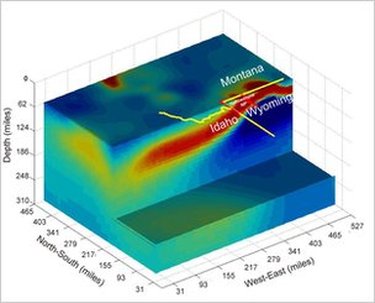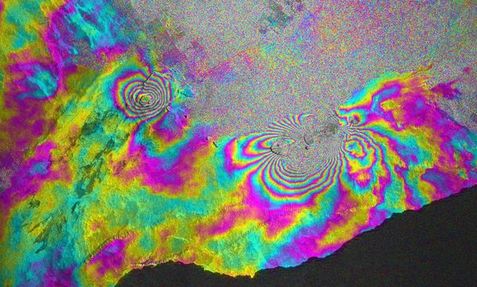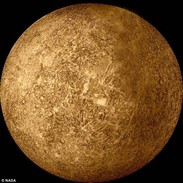|
I was shown this site a while back and just found the link for it again. A few brave volcanologists managed to get close enough to the vent of Eyjafjallajökull during the eruption in 2010 to take these amazing videos, below is an example but more can be found at http://www.mrietze.com/iceland10-2.htm. There are also some brilliant photos as well. Check it out!
I stumbled across an interesting article on the BBC website -here. A group of researches in America are using the electrical conductivity of the mantle rocks to infer the position of the mantle plume. The research hasn't been published yet but it should be an interesting read, and when it is I will discuss this more.
I thought I would share this image of Kilauea. It is an InSAR (Interferometric Synthetic Aperture Radar) image which is created using two images from radar satellites as these can determine distance quite accurately. It shows differences in surface elevation between the 11th February and March 7th. The latest round of eruptions from Kilauea began on the 5th March. This image is taken from the National Geographic Website http://news.nationalgeographic.co.uk/news/2011/04/pictures/110408-best-space-pictures-stars-nebula-volcano-iss-moons-139/#/02-space-060411_34297_600x450.jpg and was created by the NASA JPL.
The question of whether there was active volcanism on Mercury has been disputed for decades, with scientists failing to produce working hypotheses for volcanism. The reason for this scepticism is that there were assumed to be a lack of volatiles beneath the surface of Mercury. Volatiles (such as CO, CO2, H2O, SO2, H2S) are needed for an eruption to become explosive, if these volatiles are allowed to exsolve from magma (via reduced pressure as magma rises) and are present in sufficient quantities, gas bubbles of volatiles can nucleate and the process of fragmentation can occur, which will give rise to explosive eruptions. Mercury has a low atmospheric pressure - close to 0 and at lower atmospheric pressures fewer volatiles are needed to create explosive eruptions. However it is not as simple as this, with some volatiles deemed as more 'important and efficient' when considering eruption processes. For example CO2 is less efficient as it tends to exsolve at greater depths, whilst H20 is the most efficient. For a number of reasons it is unlikely that H20 is present within the interior of Mercury. Any Mercurian eruptions are therefore likely to be smaller in size (Hawaiian, Strombolian, Vulcanian) or limited to effusive (non-explosive) eruptions. There are several theories as to which volatiles are present within the Mercurian inter
With the recent flybys of the MESSENGER probe interesting aspects of the surface have been definitively identified as volcanic in origin. Images of Mercury have shown evidence of a variety of volcanic features. Within the Caloris basin, wide and relatively flat shield volcanoes (comparable to the ones seen on the Moon) have been discussed by Kerber et al. (2009) with evidence of pyroclastic deposits surrounding one of these shield volcanoes. These formations provide more than just evidence of volcanism on Mercury but also that volatiles are (were) in existence within the interior. The pyroclastic deposits are hypothesised to have been formed by the equivalent of a Hawaiian lava fountain eruption. The shield volcanoes were formed by effusive volcanism in the form of lava flows. There is also further evidence of volcanism from satellite imagery in several of the Mercurian plains. Pit craters have been identified due to their steeper walls than the ones formed by impact craters. This provides some evidence of magma chambers, it is surmised that these features formed in a similar manner to caldera collapse on Earth. Mercury orbits the sun at an average of ~58 million km and has a radius of ~2400 km. With the entry into orbit of MESSENGER the volcanic history of Mercury will start to unravel! Still to look forward to over the next couple of weeks in my brief planetary volcanism discussions - Venus, Mars, Io and a discussion of cryo-volcanism! Journal articles read in relation to this topic and which may be of interest: Kerber et al. (2009). Explosive volcanic eruptions on Mercury: Eruption conditions, magma volatile content, and implications for interior volatile abundances. Earth and Planetary Science Letters 285, pp. 263–271 Head et al. (2009). Volcanism on Mercury: Evidence from the first MESSENGER flyby for extrusive and explosive activity and the volcanic origin of plains. Earth and Planetary Science Letters 285, pp. 227–242 Gillis-Davis et al. (2009). Pit-floor craters on Mercury: Evidence of near-surface igneous activity. Earth and Planetary Science Letters 285, pp. 243–250 In other volcano news, Etna is continuing its activity, with strombolian/hawaiian activity occurring over the past few days. Ruapehu (New Zealand) sustains its signs of unrest with increased CO2 degassing and maintained high crater lake temperatures. Its taken me a while to get up and running but will now hopefully start to post more regularly. I am going to be kicking off this blog with a series of posts on planetary volcanism. I am going to wonder through the universe from Mercury outwards discussing all things volcano related.
The first blog is going to be dedicated to the planet closest to the sun, Mercury, and will be posted next week. |
Archives
July 2023
|




 RSS Feed
RSS Feed